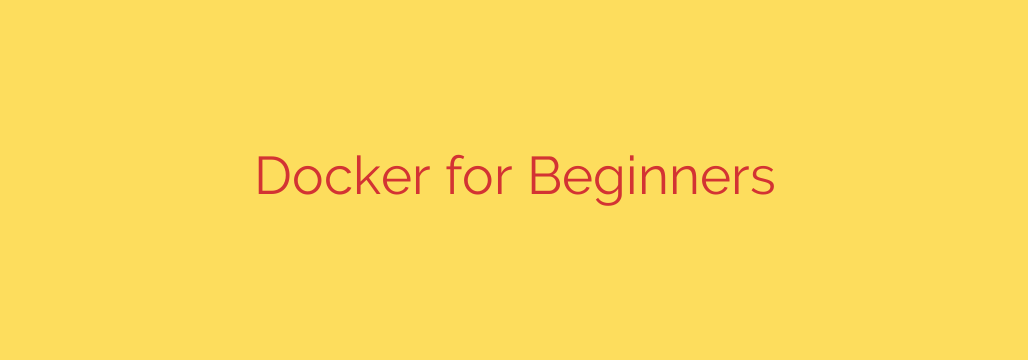
Docker Explained: Your First Steps into Containerization
If you’ve spent any time in software development, you’ve likely heard the classic phrase: “But it works on my machine!” This frustrating problem—where code runs perfectly on a developer’s computer but fails in testing or production—highlights a fundamental challenge: environmental inconsistency. Docker is a powerful platform designed to solve this very problem, and it has revolutionized how we build, ship, and run applications.
This guide will break down what Docker is, why it’s so beneficial, and how you can get started with its core concepts.
What is Docker, Exactly?
At its core, Docker is a platform for developing, shipping, and running applications inside lightweight, portable packages called containers. Think of a container like a standardized shipping container in the real world. It doesn’t matter what’s inside—electronics, food, or furniture—the container itself has standard dimensions and can be moved by any ship, train, or crane equipped to handle it.
Similarly, a Docker container bundles an application with everything it needs to run: the code, runtime, system tools, libraries, and settings. This self-contained package can then be run on any machine with Docker installed, regardless of the underlying operating system or configuration. This guarantees that the application will run the same way, everywhere.
Why Use Docker? The Core Benefits
Adopting Docker brings a host of advantages to developers and operations teams, streamlining the entire software lifecycle.
- Consistency Across Environments: By packaging the application and its dependencies together, Docker eliminates the “it works on my machine” problem. The same container that runs on a developer’s laptop will behave identically in staging, production, or any other environment.
- Portability and Flexibility: Docker containers can run on virtually any platform—your local machine, a corporate data center, or a public cloud provider like AWS or Azure. This freedom prevents vendor lock-in and simplifies migration.
- Efficiency and Speed: Containers are incredibly lightweight because they share the host machine’s operating system kernel. Unlike virtual machines, they don’t need to boot up a full guest OS, allowing them to start in seconds and use significantly fewer resources.
- Isolation: Each container runs in an isolated environment. This means an application and its dependencies are kept separate from other containers and the host system, preventing conflicts and enhancing security.
- Scalability: Need to handle more traffic? You can quickly spin up new instances (containers) of your application in seconds. This makes scaling applications far simpler and more responsive to demand.
Docker vs. Virtual Machines: Understanding the Key Difference
Beginners often confuse Docker containers with Virtual Machines (VMs), but they operate on fundamentally different principles.
A Virtual Machine emulates an entire computer system, including the hardware. Each VM runs its own complete guest operating system on top of the host OS. Think of it like building several separate houses on one plot of land—each house has its own infrastructure, plumbing, and electricity.
A Docker Container, on the other hand, only virtualizes the operating system. All containers on a host machine share the host’s OS kernel. This is more like an apartment building—all apartments share the building’s core foundation and utilities but have their own secure, isolated living spaces.
The key takeaway is that containers are far more lightweight, faster, and resource-efficient than VMs, making them ideal for modern, fast-paced application development.
The Building Blocks of Docker: Key Concepts to Know
To work with Docker, you need to understand a few essential components:
- Docker Image: An image is a read-only template used to create a container. It contains the application code, libraries, dependencies, and other files needed for the application to run. Think of an image as a blueprint or a recipe.
- Docker Container: A container is a runnable instance of an image. When you run an image, you create a container. You can create, start, stop, move, and delete containers. It’s the actual running application created from the blueprint.
- Dockerfile: A Dockerfile is a simple text file that contains a list of commands and instructions for building a Docker image. It’s the automation script that tells Docker how to assemble the blueprint.
- Docker Hub: Docker Hub is a cloud-based registry service where you can find and share container images. It’s like GitHub, but for Docker images. You can find official images for popular software like Python, Ubuntu, and Node.js, or you can push your own custom images to share with your team.
Practical Security Tips for Docker Beginners
As you start using Docker, keeping security in mind from day one is crucial.
- Use Official Base Images: Whenever possible, build your images on top of official images from Docker Hub. These are regularly scanned for vulnerabilities and maintained by the software’s developers.
- Don’t Run as Root: By default, processes in a container run as the root user, which can be a security risk. Configure your containers to use a non-root user to limit potential damage if the container is compromised.
- Scan Your Images: Use tools to scan your Docker images for known security vulnerabilities. Many CI/CD platforms and registries have built-in scanning capabilities.
- Keep Docker Updated: Regularly update the Docker Engine on your host machines to ensure you have the latest security patches and features.
By embracing containerization with Docker, you can build more reliable, scalable, and portable applications while simplifying your development workflow. Your journey into modern software deployment starts here.
Source: https://linuxhandbook.com/docker/








